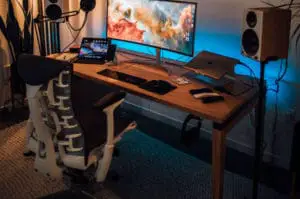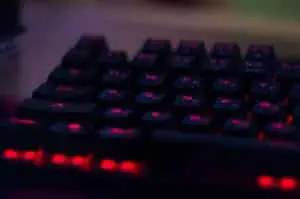A common question among gamers, day traders, CAD users or people wanting to setup a bank of multiple monitors. Is can I use two different graphics cards in one computer?
It’s possible to use two different graphics cards in one computer. Both cards will provide a graphical output to your monitors or for running separate tasks on each card. BUT these cards can’t be linked in tandem to form a GPU array using either SLI or Crossfire. In other words they don’t add additional frame rate performance. The cards will run independently of one another.
In this post I will outline the users and how to install two different graphics cards in one computer.
How to use two different graphics cards in one computer?
If you want to use two different graphics cards in one computer. Then it’s possible. But ONLY to provide additional graphical outputs to your monitors or assigning separate tasks to each card.
Two different graphics cards will NOT operate in tandem to increase frame rate performance. If you’re a gamer wanting to increase frame rate performance. Sadly two different graphics won’t work.
A two different card setup is fine for day trading applications or general productivity tasks. Two cards used this way will provide additional monitor outputs. However all the graphical processing load for a single task is handled by the primary GPU only.
If you’re a CAD user then a different card setup can be used to assign different tasks to separate GPU. For example rendering using one GPU whilst modelling on the other.
Windows 10 allows users to select the primary GPU. Users can nominate the primary card then open an application. Set the second card as primary and run the second application. Two tasks can be run on separate GPU’s. Dedicating 100% of each GPU’s efforts to each task.
NOTE: Adding an additional GPU requires a compatible motherboard with an additional PCI express slot.
What is Direct X 12 Explicit Multi-Adapter
Several years ago the use of Direct X 12 Explicit Multi-Adapter by some gaming developers allowed two different graphics cards to add frame rate performance.
Explicit Multi-Adapter meant not having to choose between Nvidia or AMD graphics cards for gaming applications. It eliminated compatibility issues and provided excellent frame rate performance scaling.
But EMA became hard to implement for many developers and the idea never really caught on. Only a handful of games and applications support Direct X 12 EMA.
If you want to add frame rate performance by adding an addition graphics card. Your best option is to install compatible (identical) cards. Either both compatible Nvidia or AMD with SLI (Nvidia) or Crossfire (AMD) bridges. Or upgrade to a single more powerful GPU.
How to connect two graphics cards in one computer?
The easiest and most effective method for adding an additional GPU to your PC is using identical or compatible cards with either an SLI (Nvidia) or Crossfire (AMD).
Either of these two methods require compatible motherboards with an addition PCI express slot.
Nvidia GPU’s use SLI or Scalable Link Interface. SLI requires Identical GPU’s, Identical VRAM and an SLI Bridge.
AMD GPU’s use Crossfire. For newer cards this only requires identical GPU’s. Crossfire bridges are only required for older cards. VRAM doesn’t have to be identical.
Using this method your GPU’s will run in tandem. Whilst the performance isn’t a perfect 2 x scaling performance for frame rates. It still provides a decent 50-80% increase in performance.
How to install two different graphics cards
Installing two different graphics cards in one computer is a similar process as installing a single card. It’s straight forward and can be done by anyone with basic technical skills.
NOTE: Before installing your new GPU. Make sure your current power supply supports both units. To check use a PSU calculator.
Power supplies are cheap and relatively easy to install. If you need a new PSU. Check out my favorite PSU units.
To install your second GPU:
- The first thing you want to do is uninstall all existing drivers. To do this go to device manager. Under the ‘Display adapters’ tab. Select the GPU to uninstall. Right click and select ‘Uninstall device’.
- Turn off your PC and disconnect from power source
- Open your computer case to access your motherboard and PCI express slots.
- Disconnect power supply cable to existing graphics card.
- Install your new card below existing card. Align new GPU up with the second PCI express slot and push card gently into place. Make sure the clip closes when the card is correctly in place. Screw the GPU against the computer case. Make sure it is securely in place.
- Connect the power supply to existing card and new card.
- Close computer case panel
- Download GPU manufacturer drivers. Follow the driver installation process outlined below. Depending on the drivers being installed.
- Return to Device manager’. Under ‘Display adapters’. Confirm that both GPU’s appears with no warnings or errors.
How to install drivers for two different graphics cards
Depending on the cards you’re installing. Will determine how best to install the drivers.
The main problem with installing two different graphics cards is that windows 10 doesn’t allow the installation of more than one set of drivers.
The following are solutions for installing drivers depending on the GPU type and generation:
How to install drivers for two graphics cards of similar generation
If you are using cards of similar generations. Both cards likely use the same driver. Nvidia and AMD drivers are designed to support a range of cards.
How to install drivers for two graphics cards not supported by the same driver
When cards aren’t supported by the same driver. Then you’ll be forced to use the older driver to run both cards.
If you’re running Windows 10 and depending on the age of the older GPU. Unfortunately, the GPU’s may not be support by the same driver at all.
How to install drivers when running an AMD with a Nvidia graphics card
If you are using an AMD with an Nvidia card. The following process is suggested:
- Install AMD card as described above (Important to install AMD card first).
- Reboot PC
- Install drivers that support this GPU.
- Turn off PC
- Install Nvidia card as described above.
- Reboot PC
- Install Nvidia drivers
- Reboot PC
Troubleshooting FAQ
After you’ve installed your graphics cards and find there’s no display with graphics card plugged in check out this link for a common fix!



